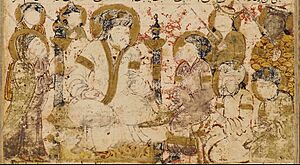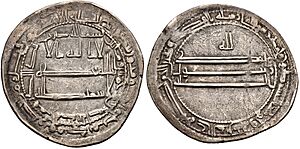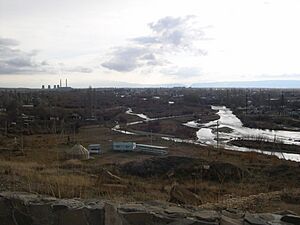- This page was last modified on 17 October 2025, at 10:18. Suggest an edit.
al-Saffah facts for kids
| al-Saffāḥ السفّاح |
|||||
|---|---|---|---|---|---|
|
|||||

as-Saffah's proclamation as caliph, from a 14th-century illustrated manuscript of Balami's Tarikhnama
|
|||||
| 1st Abbasid Caliph | |||||
| Reign | 25 January 750 – 8 June 754 | ||||
| Predecessor | Dynasty established Marwan II as Umayyad caliph |
||||
| Successor | al-Mansur | ||||
| Born | c. 721 al-Humayma, Jordan |
||||
| Died | 8 June 754 (aged 33) al-Anbar, Iraq |
||||
| Burial | Anbar | ||||
| Spouse | Umm Salama bint Ya'qub al-Makhzumi | ||||
| Issue |
|
||||
|
|||||
| Dynasty | Abbasid | ||||
| Father | Muhammad ibn Ali | ||||
| Mother | Rayta bint Ubayd Allah | ||||
| Religion | Sunni Islam | ||||
Abu al-Abbas Abd Allah ibn Muhammad ibn Ali ibn Abd Allah (born 721 or 722 – died June 8, 754), known as al-Saffah, was a very important leader in Islamic history. He was the first caliph (ruler) of the Abbasid Caliphate. This was one of the longest and most powerful empires in the Islamic world.
His nickname, al-Saffah, means "the Blood-Shedder." This name might have been given to him because he was very tough. It could also have been used to scare his enemies.
Contents
Who Was Al-Saffah?
His Family and Early Life
Al-Saffah was born in Humeima, which is in modern-day Jordan. He belonged to a powerful family called the Banu Hashim. This family was part of the Quraysh tribe from Arabia.
His family was directly related to Hashim ibn 'Abd Manaf, who was a great-grandfather of the Prophet Muhammad. Al-Saffah's family line came through ‘Abbas ibn ‘Abd al-Muttalib, who was an uncle of Muhammad. This is why his family's rule was called the "Abbasid" caliphate. Being related to Muhammad's family helped al-Saffah claim his right to be caliph.
Al-Saffah's father was Muhammad ibn Ali ibn Abdallah. His mother was Rayta, the daughter of Ubayd Allah ibn Abd Allah.
Why People Wanted Change
Many people believed that a great leader, called a mahdi, would one day come from Muhammad's family. They thought this leader would save Islam from bad rulers.
Before the Abbasids, the Umayyad dynasty ruled the Islamic world. The Umayyads had trouble keeping everyone happy. They didn't fully accept non-Arab Muslims or Shi'a Muslims. This caused a lot of anger and protests among these groups.
In 736, a revolt happened in Kufa, a city in southern Iraq. This rebellion was led by Zayd ibn Ali, who was also from Muhammad's family. Even though the Umayyads stopped this revolt, it showed that many people were unhappy with their rule.
The Abbasid Revolution
Starting the Rebellion
As the Umayyad rule weakened, al-Saffah and his family decided to start their rebellion. They chose Khurasan as their starting point. Khurasan was a large and important region in the eastern part of the Islamic empire. It included parts of modern-day Iran, Turkmenistan, Uzbekistan, Tajikistan, Kyrgyzstan, and Afghanistan.
In 743, the Umayyad Caliph Hisham ibn Abd al-Malik died. This led to more revolts in the east. Al-Saffah gained support from Shi'as and the people of Khurasan. He led his armies to victory against the Umayyads.
The Civil War
The civil war was very intense. Some Shi'a Muslims believed that al-Saffah was the mahdi they had been waiting for. They thought this war was a fight between good and evil. The Umayyads used white flags in battle, while the Abbasids used black flags. This difference in colors also added to the idea that it was a special, important conflict.
Becoming Caliph
Victory Over the Umayyads
In October 749, al-Saffah's rebel army entered Kufa, a major city in southern Iraq. His main goal was to defeat the Umayyad caliph, Marwan II.
In February 750, al-Saffah's forces defeated Marwan II at the Battle of the Zab river. This battle effectively ended the Umayyad caliphate, which had ruled since 661 AD. Marwan II tried to escape but was eventually killed in Egypt.
Al-Saffah was then declared the first Abbasid caliph. He waited until the Umayyad caliph and many of his princes were defeated before accepting the title.
New Capital and New Policies
One of al-Saffah's first big decisions was to make Kufa the new capital of the caliphate. This ended the importance of Damascus as the center of Islamic power. Iraq would now be the heart of the Abbasid empire for many centuries.
Stories say that al-Saffah was worried about the Umayyads trying to regain power. He invited the remaining Umayyad family members to a dinner party. There, they were killed. However, one survivor, Abd al-Rahman ibn Mu'awiya, managed to escape to al-Andalus (Spain). There, the Umayyad dynasty continued to rule for another three centuries.
Al-Saffah's four-year rule focused on making the caliphate strong again. He included his supporters in the new government. He also welcomed Jews, Nestorian Christians, and Persians into his government. Education was encouraged, and the first paper mills were set up in Samarkand. These mills were run by skilled Chinese prisoners captured in battle.
Al-Saffah also changed the army. Unlike the Umayyads, he allowed non-Muslims and non-Arabs to join. He chose a talented commander named Abu Muslim to lead his military.
Challenges and Succession
Not all Muslims accepted al-Saffah's rule. Some Shi'ites felt he had broken his promises to them. They had hoped their own leader, an imam, would become caliph. This disagreement caused some Shi'a supporters to feel betrayed. However, the Abbasid rule was still much stronger than the Umayyads' had been.
Caliph Abu al-`Abbās `Abdu’llāh as-Saffāḥ died from smallpox on June 8, 754. He had been caliph for only four years. Before he died, he named his brother, Abu Ja'far al-Mansur, as his successor. After al-Mansur, his nephew Isa ibn Musa was supposed to take over, but this never happened.
Abbasid Military Activities
The Battle of Talas
A very important battle happened in 751, known as the Battle of Talas. This was a fight between the Abbasid Caliphate (with their ally the Tibetan Empire) and the Chinese Tang dynasty.
In July 751 AD, the Tang and Abbasid armies met near the Talas River in Central Asia. They were fighting for control of the Syr Darya region. After several days of fighting, the Karluk Turks, who were fighting for the Tang, switched sides and joined the Abbasids. This change helped the Abbasids win a big victory.
This defeat stopped the Tang dynasty from expanding further west. It also gave Muslims control of the Transoxiana region for the next 400 years. This area was important because it was on the Silk Road, a major trade route. Historians also think that Chinese prisoners from this battle might have brought paper-making skills to the Middle East, which later spread to Europe.
The exact number of soldiers in the Battle of Talas is not known. Some estimates say the Abbasid army had 200,000 troops, while the Chinese had 10,000 Chinese and 20,000 Karluk soldiers. These numbers might be much higher than the real ones.
The Tang army suffered a huge defeat. The Karluk mercenaries, who made up two-thirds of the Tang army, turned against them during the battle. They attacked the Tang from behind, while the Abbasids attacked from the front. The Tang commander, Gao Xianzhi, realized they were losing and managed to escape with some of his soldiers. Only about 2,000 out of 10,000 Tang troops made it back.
After the battle, Gao Xianzhi was planning another attack against the Arabs. But then, a major rebellion called the An Shi Rebellion broke out in China in 755. All Chinese armies in Central Asia were called back to China to fight this rebellion.
Also in 751, the Byzantine Emperor Constantine V led an invasion into the Caliphate's territory. The Byzantines captured some cities, but they didn't try to keep control of them for long.
Succession and Legacy
Al-Saffah ruled for five years. After his death, his brother al-Mansur became caliph. Al-Mansur ruled for almost 22 years (754–775 AD) and worked hard to make the Abbasid caliphate strong.
Al-Saffah had chosen his brother, al-Mansur, as his heir because his own son was too young to rule. Al-Mansur then named his nephew Isa ibn Musa as his heir. This plan was supposed to prevent arguments within the Abbasid family. However, al-Mansur's right to be caliph was challenged by his uncle Abdullah ibn Ali. Once in power, al-Mansur had his uncle imprisoned and later killed.
Even though al-Saffah's son never became caliph, his children remained important. His daughter, Rayta, married his nephew Muhammad (who later became Caliph al-Mahdi). Their sons, Ubaydallah and Ali, also held important positions in the empire.
See also
 In Spanish: As-Saffah para niños
In Spanish: As-Saffah para niños
- al-Mahdi, nephew and son-in-law of as-Saffah.
- Ubaydallah ibn al-Mahdi an Abbasid Prince and Grandson of as-Saffah.
- Sulayman ibn Ali al-Hashimi an Abbasid governor of Basra from 750 to 755.
- Battle of the Zab a battle that took place on 25 January 750. It spelled the end of the Umayyads and the rise of the Abbasids
- Abbasid Revolution was the overthrow of the Caliph Marwan II by as-Saffah.





